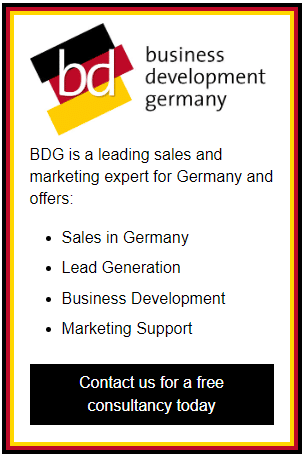Introduction
Companies across Europe and around the world are interested in selling products and services in Germany. Germany is still considered Europe’s economic powerhouse and it’s safe to assume that successfully entering the German market can help lead to further expansion into other European countries.
The general perception is that Germany can be rather conservative, difficult to sell to (and in) and that decision-making processes take longer. These tendencies are, more often than not, true. But, they are also facets of the typical German approach to new possibilities – analytical, quality-oriented and maybe, yes, just a bit conservative.
Today, digitalization and sales automation through diverse applications add a new dimension to what sales has been about for decades in Germany. Many foreign companies are pleasantly surprised to learn that present day Germany offers a mixture of everything from a classic sales approach with snail mail advertising all the way up to the most advanced AI solutions.
Once sales goals have been reached in Germany, there is a primary, outstanding and very important benefit – clients tend to remain loyal to the new business partner and/or product.
So, even if it may seem difficult and a bit discouraging at the beginning, the extra effort will be worth it in the long run.
An overview of the various sales components
Sales Workforce
It is difficult to determine the exact number of people directly involved in sales because the German labor statistics only count employees according to industry and subsector, but not to what work is actually done. In the “trade” field to which also retailers and others belong, there are 6 million employees and it can be assumed that many of them have sales-oriented work. According to the federal statistics office in Wiesbaden, at least 750,000 employees are working in sales and marketing with only around 35% being female.
In Germany, salespeople are generally viewed favorably and are respected. According to a survey of 2,700 buyers in 6 countries Germany held the top score with an 80% satisfied response. Many companies are aware that sales work is the beginning of business development and relationships and respect competence in this field.
This is reflected in what sales people earn. According to Stepstone Germany, the starting salary of a young sales professional begins at approximately 49,000 EUR per year (while the average salary of newly starting professionals in other areas is 37,200 EUR. Normally, extra benefits and incentive fees add on to this and it is not unusual that an experienced or successful sales employee can make between 75 -100,000 EUR per year. Sales executives can make significantly more. In addition, it is common to be generous with the proper tools to do the job. These often include a laptop, iPhone and car as the minimum package in many German companies. (Since Germany is famous for its car manufacturing, it goes without saying that many sales executives are seen in German brand cars).
Is there a typical German sales structure in Companies?
As in other countries, Germany is very diversified in terms of size of company, industry and target audience. But there tends to be a certain structure of sales organizations in German companies. To begin with, a classic distinction is made between external sales and sales office. The external sales personnel take care of clients, go to personal meetings and events and are often very free in their own organization. The sales office is often its own entity within a company and is dedicated to supporting the external sales, preparing order forms, adjusting documents and taking care of complaints or correspondence.
If the company is big enough there will be a sales executive amongst the board of directors. Otherwise this is taken care of by the CEO personally.
In small companies it is normal to have one or a few people taking care of sales and “external relations”.
In the last couple of years sales outsourcing is a growing phenomenon in Germany. Especially engineering companies or others with a strong technological orientation (of which there are many in Germany), sales and marketing is considered as the opposite and something that is gladly given to external sales professionals.
B2B Sales
Selling to companies and businesspeople is increasingly following international standards and an assimilation has been visible since the internet was introduced and globalization intensified.
The German selling landscape in B2B has also adapted to this and is, for example, more and more used to communicating in English. This was unthinkable just a handful of years ago.
Comparing sales in the Anglo-American part of the world with Germany, one particular difference is worth mentioning – writing vs. talking! The German customer often views written communication and documentation with great interest and uses it to validate the quality of the proposal. Keeping this in mind, it is recommended that sellers producie well-written and structured presentations, brochures, flyers and offers to potential German clients.
These “sales tools” can be very sophisticated and a German counterpart will most probably look at the seller’s website and the imprint in order to make a determination of the seriousness of an offer before further dialogue is started. Fancy “storytelling” alone, using superlatives and generic pictures and graphics can have a negative impact and should be avoided.
In reaching out to companies, there may well be many attempts made to “get through” to the right decision maker. Processes and also internal communication can be surprisingly standardized and finding a right contact and getting an answer can take weeks. In very big organizations it may take months. It’s always a good idea to send a well-written email after a meeting or call to recap and to present the details of the business proposal.
Attachments with professional and purpose-fulfilling information are welcome.
Also, the German business email has a detail to keep in mind. If an email is sent from a German company, it is mandatory to provide company details like who is Managing Director, where the company is registered and so on. There are even different rules for each type of company. Since this is usual in Germany, it is recommended to always use an informational signature when interacting with clients. This is considered to be trustworthy and professional.
B2C Sales
Cold calling is in principle not allowed in Germany. Due to the so-called UWG which is the German legislation “unfair competition act”, previous consent of the call recipient is mandatory. This, in combination with the General Data Protection Regulation (GDPR) that was implemented by the EU on the 25th of May 2018, allow only very narrow game rules for reaching out to people on the phone.
Also, it is notable that the ‘German consumer’ can be characterized as sensible in terms of how he or she is contacted or which rights he or she has and so on. There are numerous German magazines, consumer protection organizations and even television shows that constantly review the market.
Product quality and reliability is something that is highly appreciated, and documentation and proof of effectiveness is very much appreciated. The leading German product review institute is called “Stiftung Warentest” which freely translates to ‘Foundation for Testing Goods’. Stiftung Warentest reviews products and services. A product or service and earning the highest rating of “very good” is often a sales success on its own. This institute was founded in 1964 and since then others have been established.
Sales approaches in the German B2C sales can vary strongly according to geography. The norther part of the country is known to be more direct and open, while the southern part is said to be more conservative and hesitant. Also, though reunified there are still great differences between East and West. Wages are lower in the East and other living conditions differ.
In essence, solid preparation is advisable before starting B2C sales in Germany. The formal requirements should be met and with thorough research, the standards for the respective product group identified. This, together with a solid, facts-based communication lays the groundwork for consumer acceptance.
Conclusion
Selling in Germany requires a fair amount of preparation in order to have a full understanding of the mechanisms before starting. Generally, it is considered to be a demanding market and both business as well as consumers are well informed about product quality standards. A thorough substantiation of selling arguments – in writing – together with professional communication tools are basic ingredients for being successful in Germany.
German Sales in a historic perspective
In 1936, when Dale Carnegie’s famous book “How to Win Friends and Influence People” was published in the USA, in Germany modern sales techniques and management practices were unknown.
The earliest sign in Germany of interest in the topic was the 1971 international bestseller “Psychology & Technique of the Sales Pitch” by Jan K. Wage. As the modernizing German telephone network was covering more and more of (at least) West Germany, it slowly became normal to contact potential buyers/customers by phone and to think more systematically about how to refine the sales pitch.
Throughout the 1980’s sales really took off and figures like Erich-Norbert Detroy and Hans-Uwe Köhler influenced the way that sales optimized and emotionalized in many industries and companies. Suddenly the “art of the sale” experienced a transformation and was professionalized.
After the fall of the wall in 1989 and the reunification of West and East Germany, the landscape was literally shaken. Most former East German companies were closed or overtaken by stronger West German capitalist groups, leaving approximately 17 million “new” consumers with a hunger for products and brands that had not been allowed behind the “Iron Curtain”. Wild stories continue to be heard today about how everything with a western appearance was sold at high prices to former DDR citizens in the early 1990’s.
It is likely that the unexpected reunification of Germany of prompted explosive sales development even further. A boom took place and flamboyant coaches like Dirk Kreuter and Jürgen Höller introduced motivation camps and limitless sales-success workdhops and seminars.
With the recession following the dot-com crisis of the early 2000s, Germany entered a new phase in sales. With an economy that was described by other European countries as the “weak man of Europe” creativity and new approaches were necessary for Germany. One result was a call center boom that lasted until 2009. Another was a new general awareness of networks and platform like Xing and others.
Today, digitalization and sales automation through diverse applications add a new dimension to what sales has been about for decades in Germany. However, many foreign companies are surprised that Germany today offers a mixture of everything from a classic sales approach with (snail-)mail advertising to AI-solutions.
Article contributed by bdg Consulting GmbH. Business Development Germany was founded to help and support foreign companies onto the German market and is now a renowned expert in this field.
Web: www.businessdevelopmentgermany.com
Email: [email protected]


